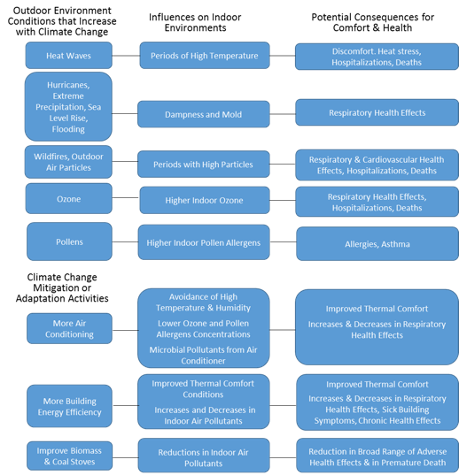Climate Change Background
Climate Change and IAQ Background
Climate Change and Indoor Air Quality: Background
As depicted in Figure 1 below, climate change is likely to change several aspects of indoor environmental quality (IEQ). Examples include more frequent periods of high indoor temperatures and associated heat stress, driven by more frequent outdoor heat waves; changes in indoor air pollutant levels driven by changes in outdoor air pollution; and increased indoor dampness and mold problems as a consequence of having more frequent severe storms. Also, IEQ will be affected, positively or negatively, or both positively and negatively, by changes in building designs and operational practices implemented to mitigate and/or adapt to climate change. The magnitudes of the changes in IEQ will depend highly on the extent of climate change and on the nature and extent of climate change mitigation and adaption measures that are implemented. If effects of climate change on IEQ are neglected, comfort and IEQ-related health may suffer. However, with sufficient attention to IEQ, climate change adaptation and mitigation efforts could improve outdoor and indoor environmental quality and thereby improve health.

Figure 1. Examples of how climate change may affect indoor environments and health (adapted from [1])
The effects of climate change on IEQ and health are expected to vary regionally and among segments of the population. The elderly, people with poor health, and the economically disadvantaged may be most affected. While many of the issues addressed in this review are relevant throughout the world, most current literature pertains to the effects of climate change in the more developed sections of the world, especially North America and Western Europe; thus, this review has the same overall bias. There are anticipated effects of climate change on health that are unrelated to IEQ that are not discussed. Also, changes in IEQ attributable to climate change may occur simultaneously with other changes that also affect IEQ but are not attributable to climate change. For example, the implementation of outdoor air quality control measures and population growth will modify outdoor and associated indoor ozone levels in many cities, at the same time that changes in climate affect ozone levels. To the degree possible, this review addresses the isolated effects of climate change.
The following sections of this review incorporate text from [1]: Introduction; Thermal Stress and Deaths During Heat Waves; Dampness and Mold from Severe Storms and Sea Level Rise; Wildfires; Increases in Ozone, and Building Energy Efficiency Measures.
1. Fisk , W.J., Review of some effects of climate change on indoor environmental quality and health and associated no-regrets mitigation measures. Building and Environment, 2015. 86: p. 70-80. https://dx.doi.org/10.1016/j.buildenv.2014.12.024.